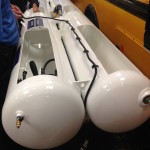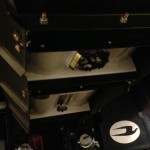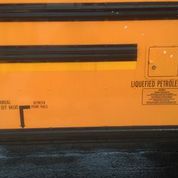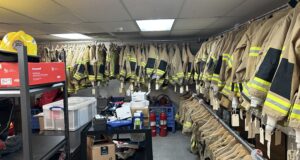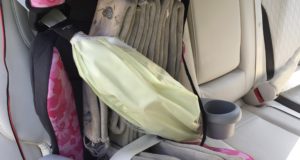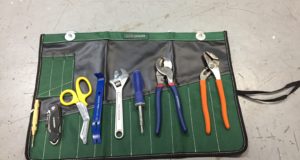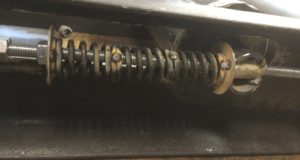 Last month while at the School Transportation News Expo in Reno I learned about the new 98 gallon propane tank we will be seeing on some of Blue Birds school buses. Read more about it HERE. Also read about and let us know what you think about Green rub rails on alternative fueled school buses HERE.
Last month while at the School Transportation News Expo in Reno I learned about the new 98 gallon propane tank we will be seeing on some of Blue Birds school buses. Read more about it HERE. Also read about and let us know what you think about Green rub rails on alternative fueled school buses HERE.
The information on propane tanks for this post was passed along from Erik Rickenbach (Rescue Techs) after his recent Q&A with Rousch engineers. There is a lot to learn in the following.
“LIKE” FIRST DUE TACKLE ON FACEBOOK
1. The flow of gas is shut off at the tank automatically when either the ignition switch/key is off?
Correct.
2. It will also shut off at the tank if the engine stalls? (And if so, the assumption would be that a collision that creates a stall scenario would shut off that valve?)
Correct.
3. Will disconnecting the buses 12-volt electrical system (removing battery cables) cause the valve to close?
Correct. Disconnecting the battery would immediately close the valve.
Correct on both. There is an excess flow valve in the tank that will significantly reduce flow if there is a severed supply line near the tank. It does not completely stop the flow of gas. It is really just a third level redundant safety if a line breaks, the automatic shutoff fails, and the manual shutoff valve cannot be safely accessed.
5. There is no specific crash sensor or something similar that will shut down the gas in this event?
No. The fuel will be turned off if the engine stalls, the key is turned off, or electrical power is externally removed (kill switch, battery disconnect, etc.) but otherwise the fuel will stay on so long as the engine stays running.
Correct. NFPA 58 requires the manual shutoff valve to be directly on the tank. It is accessible without tools, but does require access to the tank (which in this case is under the bus).
7. Other than being aware of and monitoring for LPG release, all other standard safety procedures for dealing with vehicles involved in accidents will still apply to these vehicles?
Correct.
“LIKE” RESCUE TECHS ON FACEBOOK
Here are numerous points about the propane system on Blue Bird school buses built by Rousch. This information is straight from the engineers.
- The propane autogas tank is designed and certified to ASME section VIII design standards for its maximum working pressure (312 psi).
- Standard developed for permanently mounted vehicle tanks and includes significant safety factors in design and construction.
- ROUSH CleanTech has tested tanks to over 1,300 psi without failure. This is over 4x the maximum working pressure and not required.
- All tanks are equipped with a pressure relief valve (PRV) which is set to the maximum working pressure (312 psi) and sized to ensure that even if the full surface of the tank were exposed to fire, the tank would still not be exposed to excessive pressure and would not rupture.
- The PRV is internally vented to the vapor space of the tank, ensuring that only vapor is emitted.
- The PRV vent is routed through a 90 degree brass fitting, which includes high melting point and breakaway features to ensure that it cannot cause a system failure.
- This is also the location of the remote bleeder port, used in annual inspections of the overfill prevention device (OPD).
- A remote valve allows the inspection to occur without needing to remove the tank cover plate and with no potential for releasing propane vapors inside the vehicle.
- All tank openings are either protected by a one-way check valve so fuel can only go in (fill valve, return valve), manual, automatic and excess flow valves flow valves (supply valve), or a sufficiently small orifice (bleeder valve) to ensure that even if the valve were open, it would not result in a combustible mixture.
- The odorant level of propane autogas is extremely high relative to its flammability, which ensure that an operator can detect a leak and get it corrected long before it poses a safety concern.
- All components are protected such that even if there were a vehicle fire, no component would be exposed to burnt pressure (propane can return to the tank, where it can be controllably vented through the PRV if the extreme conditions do occur).
- For the fuel lines, the only excess flow protection is at the supply valve at the tank. If there is a very large leak in the system, the excess flow valve will trip and significantly restrict flow.
- This valve is located inside the tank and will function even if there is a catastrophic failure of the manual and automatic shutoff valves.
- This is designed primarily to function for massive mechanical failure (for instance, a crash where the supply line is severed), and is a backup to the automatic shutoff valve which would also close in this condition (either due to the RCM detecting impact or engine stall).
- If there is a small leak in the fuel line system (‘small’ meaning that it does not cause engine stall), the engine will continue running and fuel will continue leaking until the operator shuts off the engine.
- This is similar to gasoline systems, except that with propane autogas, the leaked fuel is much less likely to ignite, and is much easier for the operator to detect due to the odorant.
- The supply valve is automatically shut off when the engine stalls or if the operator turns off the key; at that point the only fuel that can leak is the residual fuel in the lines.
Pass it on!
 First Due Tackle Pass It On – Firefighter, Rescue & Extrication Training
First Due Tackle Pass It On – Firefighter, Rescue & Extrication Training
